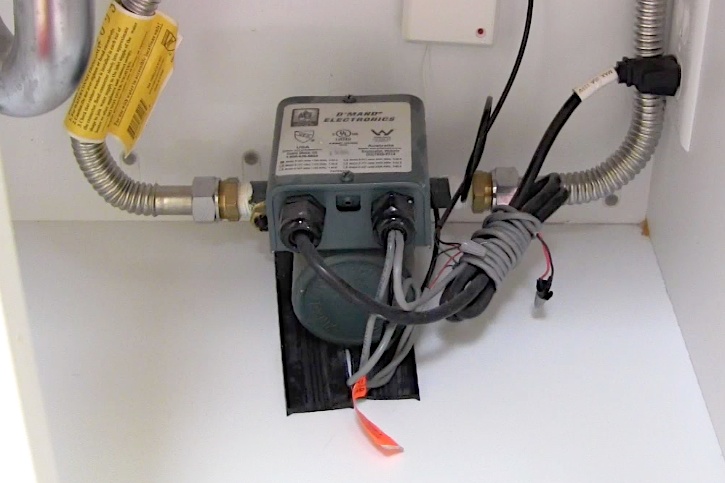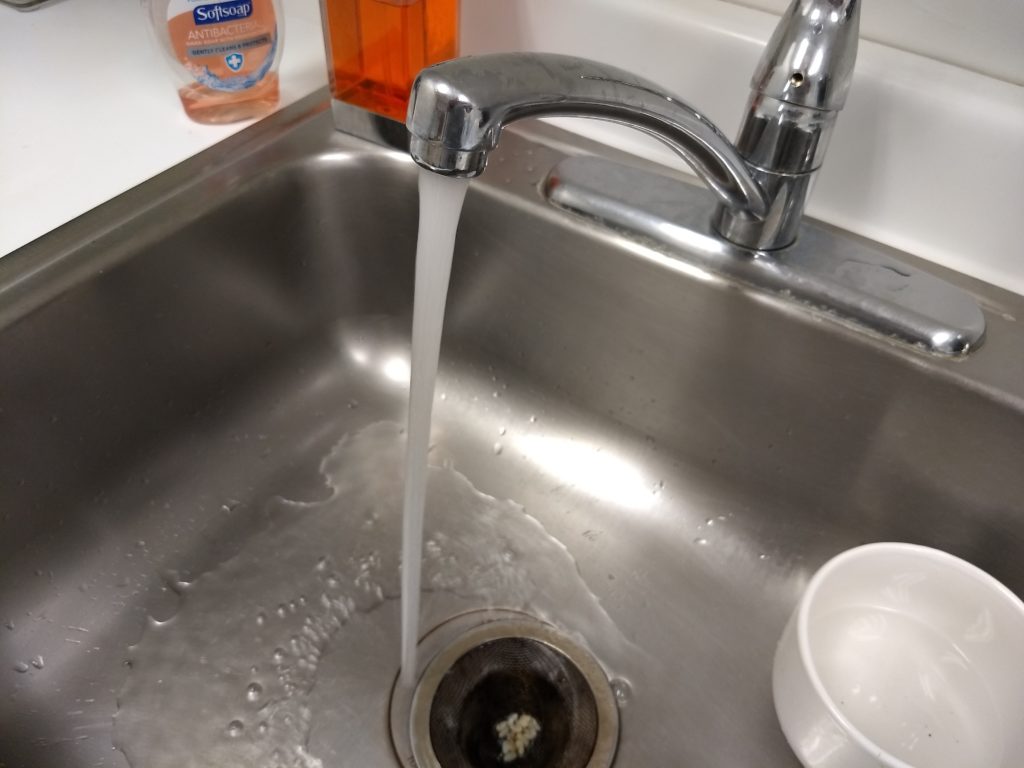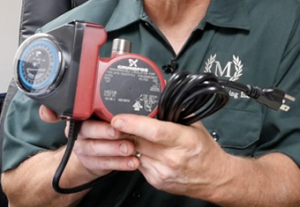
A hot water recirculation pump saves water, time and money simultaneously. Photo: American Ratings Corporation ©2018
Since the mid-20th century, water conservation has gone from being a fringe concept to a standard practice, which is why water-efficient plumbing fixtures and appliances are simply the norm nowadays. However, despite these developments, there’s one case of water waste that remains widely ignored: wait times for hot water. Whether at the sink or the shower, the lapse between when hot water is turned on and when it arrives represents one of the leading causes of water waste today…and it’s time we started addressing it.
Wait = Waste
By doing some simple math, we can get a clear picture of how much water is actually wasted by wait times for hot water. Let’s assume you have a generic low-flow showerhead that emits 2.5 gallons per minute (gpm) and it takes one full minute for hot water to arrive. That’s 2.5 gallons wasted per shower. Now, assuming you shower every day, let’s multiply that by 365—now you’re up to 912.5 gallons annually. Multiply that by 10 and that’s 9,125 gallons wasted over the course of a decade.
But the shower isn’t the only place where hot water gets used. If you’re like most people, you prefer to wash your hands (as well as your dishes) in hot water—a wise practice, as it cleans more effectively than cold water. So, let’s assume you wait for hot water at a sink at least twice a day, your faucet has a 1.5 gpm flow rate and it takes a full minute for hot water to arrive. This comes to three gallons per day or 1,095 gallons annually. Add this to the total wasted annually for showering and you’re looking at roughly 2,000 gallons of water wasted per year.
Of course, the figures we’re using here are merely for the sake of example—in reality, wait times for hot water vary considerably from home to home. However, while generalized, these figures are by no means unusual, and in some cases they may be modest in comparison to actual levels of waste. One thing is for sure: These levels of waste are substantial and need to be addressed.

A low-flow sink aerator won’t reduce waste while waiting for hot water to arrive. Photo: American Ratings Corporation ©2018
Causes of wait times
What exactly causes wait times for hot water? And why do they vary from home to home? This boils down to two main factors:
- The location of the water heater. Specifically, this applies to its location in relation to the home’s water-dispensing fixtures. The further the distance between the heater and a fixture, the further hot water must travel to get there.
- The diameter of the water piping. Pipes that are wider in diameter store more latent water, which must exit the pipe before hot water can arrive. Since a faucet’s flow rate remains the same regardless of pipe diameter, larger pipes also increase wait times.
These causal factors are often exacerbated in homes built within the last 25 years. Why? Because newer homes tend to be larger, which creates increased distances between the hot water heater and water-dispensing fixtures. Furthermore, the plumbing systems in many modern homes were built with wide-diameter water pipes, as required by updated building codes. The result: Longer wait times and more wasted water.
So, what can you do? After all, you probably aren’t going to wash your dishes in cold water or start taking cold showers every day. You could use containers to catch the water, which is useful if you’re a gardener. However, if you don’t have any plants to irrigate, this may not be worthwhile (and it’s pretty inconvenient either way). Wouldn’t it be nice if there was a simpler solution?
The solution: Hot water recirculation
A hot water recirculation pump is a device that cuts wait times for hot water down from minutes to a few seconds. It does this through a complex process of recirculation, which consists of two simultaneous actions:
- Standing water in the hot water line is sent back to the water heater to be used at a later time. This occurs via either a separate piping return or the cold water line, depending on how the pump is installed.
- Hot water is drawn directly from the water heater to the fixture in use. When the heated water reaches the fixture, a temperature-controlled switch prompts the pump to turn off.
By performing this dual process, a hot water recirculation pump can deliver near-instant hot water and conserve thousands of gallons of water per year, per fixture.
Pumps can be integrated as part of a new construction design or installed as a retrofit application. In the latter instance, the pump is spliced into the hot and cold water lines of the existing plumbing system.

By eliminating wait times for hot water, a recirculation pump conserves thousands of gallons of water per year. Photo: Mason Plumbing, Inc. ©2018
In terms of energy efficiency, an on-demand hot water recirculation pump is far and away the best option. Some recirculation systems have pumps that run constantly or on a timer, but both types inevitably waste energy. In contrast, a button-activated, on-demand model only functions as needed, which minimizes energy expenditures.
With the substantial amount of water they save, recirculation pumps represent a clear solution to the problem of wait times for hot water. If this solution were adopted on a wide scale, the total savings would be incalculably significant. That’s why, in an age when water is becoming increasingly scarce, every home should have a hot water recirculation pump.
Still not convinced?
Even if you’re in favor of water conservation, it may not be a motivating factor for you, especially when it comes to making a financial investment. If that’s the case, consider these additional, practical reasons to invest in a hot water recirculation pump:
It’ll save money.
As with most utilities, water rates have consistently risen over time, and particularly so in California, where residents pay some of the highest rates in the country. What’s more, rates are likely to rise further, and in some cases are already slated to. In San Francisco, for example, the Public Utilities Commission has approved incremental water and sewer service hikes over the next four years to finance improvements to the city’s water infrastructure. And it’s not just the big cities where water rates have and will continue to soar—even small communities are feeling the pinch of high prices.
Considering the ever-increasing cost of water, it makes clear financial sense to invest in water-saving strategies, and to do so where they’ll have the biggest impact. Since a hot water recirculation pump can save an estimated 16,000 gallons per year in a four-person household, there’s no better place to start.
It’ll save time.
In this fast-paced day and age, we have less time to wait around for things, and that includes hot water. Plus, just as those small amounts of wasted water add up incrementally, so do the minutes spent waiting for hot water. Let’s say you spend two minutes each day waiting for hot water—over the course of a year, that amounts to 730 minutes, which means you’ll have squandered 12 hours standing by the tap. Like water, time is a limited resource, and a recirculation pump will allow you to utilize both more wisely.
It’s surprisingly affordable.
Perhaps the best reason to get a hot water recirculation pump is the fact that it’s not very expensive, as far as home improvements go. Roman Scanagatta, owner of Roman’s Plumbing, Inc. in Petaluma, breaks down the typical cost: “To do a retrofit recirculating system in one bathroom, the pump and labor together runs $695. Each additional zone is $250, so if you wanted to do your kitchen and another bathroom, it would cost another $500 on top of that.” Of course, as one plumber’s rate, these prices aren’t definitive. However, given a ballpark estimate of $1,200, retrofitting all your home’s water fixtures will likely cost less than your annual water bill—which, going forward, will be substantially reduced.
All things considered, installing a hot water recirculation pump in your home is a clear win-win. It substantially reduces waste, not only of water, but of your own time and money. So what are you waiting for?
